Cleaning Information for Granite Sinks

Day to day care
Your Granite sink is manufactured to the highest possible standards. To maintain its good looks, Carron Phoenix suggests you follow these guidelines.
Most deposits can be removed with washing up liquid and hot water followed by a clean water rinse. It is also good practice to then dry the sink with a soft cloth as otherwise limescale can build up on the surface.
lean off heavy staining liquids such as dyes and vegetable juices as soon as possible. Then remove any remaining marks using Coloured Sink Cleaner.
It is also good practice to then dry the sink with a soft cloth – such as a Microfiber Cloth – as otherwise limescale can build up on the surface.
Avoid the use of a plastic washing up bowl however as this will over time cause the development of regular abrasion marks over the sink’s surface.
The quality of your water can affect the good looks of your sink by giving the appearance of staining. This ‘staining’ is generally a build-up of limescale or similar mineral deposit, particularly prevalent in hard water areas.
Limescale readily absorbs staining agents such as tea, coffee, red wine etc, spoiling the appearance of your sink. For this reason always rinse and dry your sink after each occasion you use it to avoid mineral deposits being left behind on the surface when the water evaporates.
To remove any limescale that has built up on your sink, try using a proprietary limescale removing product such as Viakal® or Limelite®. Alternatively, soak in a solution of one part vinegar to three parts water. This will loosen the scale, making it possible to scrub it away with an abrasive pad and kitchen sink cleaner.
Carron Phoenix recommends…
As with all Carron Phoenix sinks, we recommend regular cleaning and maintenance to keep your granite sink looking its best.
Specific problem areas and recommended treatments
Your Granite sink is made from an extremely hard wearing material. Any metal pots, pans or cutlery dragged across its surface will initially leave marks.
However these marks are actually metal deposits on the sink’s surface and can easily be removed by scrubbing with an abrasive pad and kitchen sink cleaner.
If a “stain” becomes deeply ingrained fill the bowl firstly with 40 parts water followed by 1 part bleach (or biological washing powder) and soak overnight.
Drain, then rinse thoroughly with water. Note – this should not be used as a routine cleaning!
Cleaning tips
Don’t forget! – always finish off by rinsing your sink thoroughly with clean water to remove any residue, then dry it with a soft cloth to prevent build-up of limescale.
Take care to avoid
- Leaving bleach or cleaning agents containing bleach, or chlorinated solvents (paint strippers and brush cleaning products) on your sink for any length of time. Examples of cleaning agents containing bleach include many of the new ‘trigger-dispense’ products, most domestic dishwasher liquids and some multipurpose cream cleaners.
- If bleach is necessary, eg. to clean the overflow or waste outlet, squirt into the hole, leave for 2-3 minutes only, then rinse thoroughly with clean water. Under no circumstances leave in contact with the surface for longer than 30 minutes.
- Try to avoid dropping sharp objects onto the sink as they may chip or damage the surface. They are also likely to be damaged themselves!
- Leaving wet cleaning aids on the sink (such as cloths, pads, containers). These trap water causing limescale build up when the water evaporates.
- Using a plastic washing up bowl. Particles of grit or glass could become embedded in the base of the plastic bowl and these will scratch the sink.
